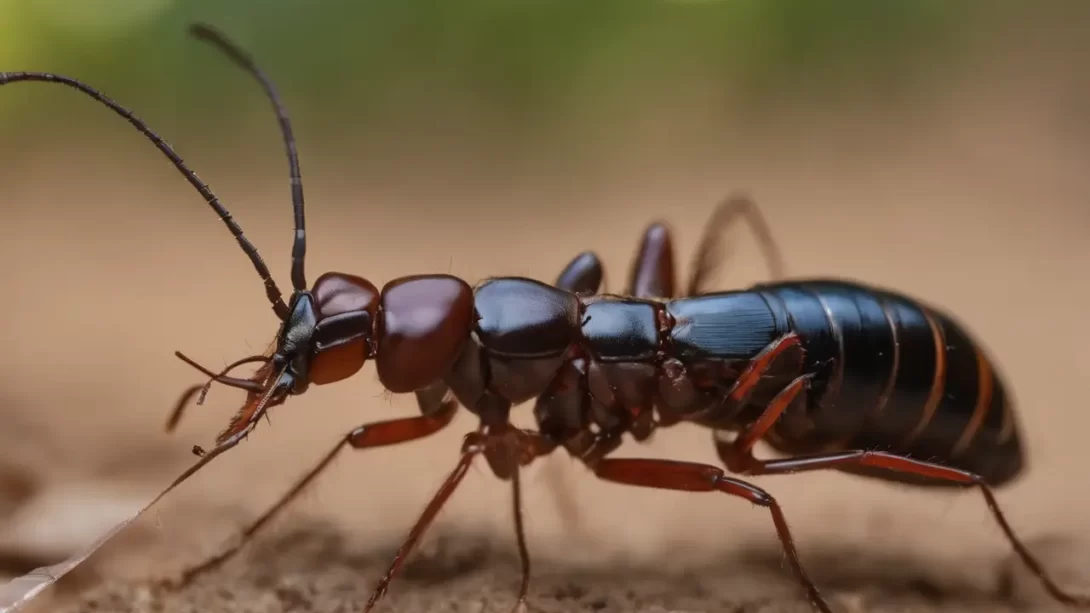Earwigs are often misunderstood insects, surrounded by myths and misconceptions, particularly regarding their interaction with humans. One such misconception is that they crawl into human ears, which is largely unfounded. This article aims to provide accurate information about what an earwig bite looks like, helping individuals identify and properly respond to such an incident.
Earwigs
Earwigs are small, elongated insects with pincers (cerci) at the end of their abdomens. These pincers are more prominent in males and are used for defense and mating rituals. Contrary to popular belief, earwigs are generally harmless to humans and do not actively seek to crawl into human ears. They might bite if they feel threatened or trapped, such as when accidentally pressed against human skin.
Why and When Earwigs Might Bite
- Earwigs are not aggressive by nature and typically bite only when provoked or mishandled.
- They might bite if they are trapped in clothing or bedding or if someone attempts to handle them.
Characteristics of an Earwig Bite
An earwig bite can be surprising but is usually not serious. Understanding its appearance and symptoms can help distinguish it from other insect bites.
Appearance
- An earwig bite usually appears as a small, red mark on the skin. It might look like a tiny pinch or puncture wound.
- The bite may be accompanied by slight swelling, redness, and sometimes a pair of tiny dot-like marks where the pincers have pierced the skin.
- In most cases, the size and shape of the bite are minimal, without significant inflammation or blistering.
Symptoms
- Common symptoms include minor pain or a burning sensation immediately following the bite. The area might also itch.
- Unlike bites from some other insects, earwig bites typically do not lead to severe allergic reactions. However, reactions can vary depending on individual sensitivities.
- Symptoms usually resolve quickly, often within a few hours to a day.
First Aid and Treatment
Although an earwig bite is generally not serious, proper first aid can help alleviate symptoms and prevent infection.
First Aid Steps
- Clean the Bite: Wash the affected area with soap and water to remove any debris and prevent infection.
- Apply Cold Compress: To reduce swelling and alleviate pain, apply a cold compress or an ice pack wrapped in a cloth to the bite site for a few minutes.
- Avoid Scratching: Scratching the bite can increase irritation and risk of infection. Keep the area clean and avoid touching it unnecessarily.
- Use Topical Treatments: Over-the-counter anti-itch creams or antihistamines can help relieve itching. Applying a mild hydrocortisone cream can also reduce inflammation.
When to Seek Medical Attention
- If the bite shows signs of infection, such as increased redness, swelling, pus, or if you experience an allergic reaction, seek medical attention promptly.
- While rare, some individuals may have a more significant reaction to an earwig bite. Symptoms like difficulty breathing, swelling of the face or lips, or severe itching warrant immediate medical care.
Preventing Earwig Bites
Preventing earwig bites largely involves reducing their presence around living spaces.
Reducing Earwig Habitats
- Maintain a Dry Environment: Earwigs are attracted to moisture. Eliminate standing water and damp areas around your home.
- Seal Entry Points: Check and seal cracks and crevices in windows, doors, and foundations to prevent earwigs from entering the home.
- Clear Yard Debris: Remove leaf piles, mulch, and other organic debris where earwigs may hide.
- Use Light Traps: Attract earwigs away from living areas by setting up light traps. Earwigs are nocturnal and are attracted to light.
Safe and Effective Earwig Control
- Use natural or chemical earwig control methods cautiously. Natural deterrents like diatomaceous earth can be effective. If using insecticides, follow the manufacturer’s instructions and apply them in areas where earwigs are most active, away from human and pet activity.
Conclusion
Earwig bites, while uncommon and generally harmless, can cause minor discomfort. Identifying an earwig bite is relatively straightforward – it typically appears as a small, red mark, often with slight swelling and a pair of tiny puncture marks. Immediate symptoms usually include mild pain or itching, which can be effectively managed with simple first aid measures like cleaning the area, applying a cold compress, and using topical treatments.
Awareness and prevention are key in avoiding earwig bites. Maintaining a dry environment, sealing potential entry points into your home, and keeping outdoor areas clear of debris can significantly reduce the likelihood of encountering earwigs. When needed, using light traps or appropriate insecticides can help control their presence around your living spaces.
In summary, while earwig bites can be a nuisance, they are generally not a cause for concern. With basic knowledge of what these bites look like and simple preventive measures, you can effectively manage and minimize interactions with earwigs. Understanding these aspects ensures a comfortable coexistence with these unique insects, which, despite common myths, pose little threat to humans.



